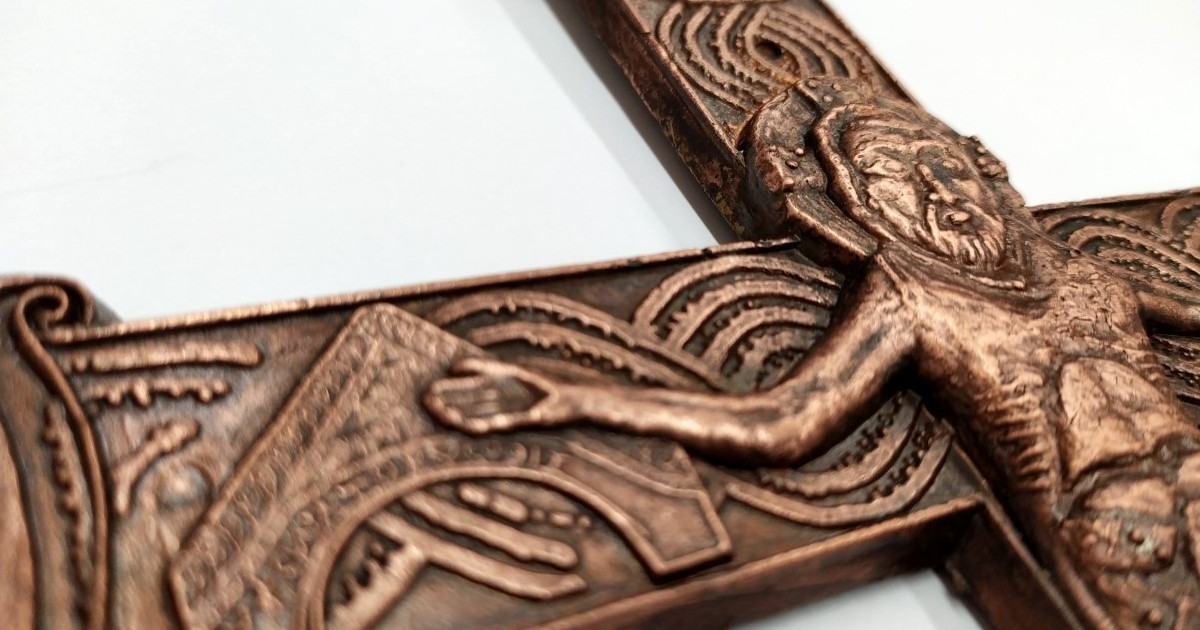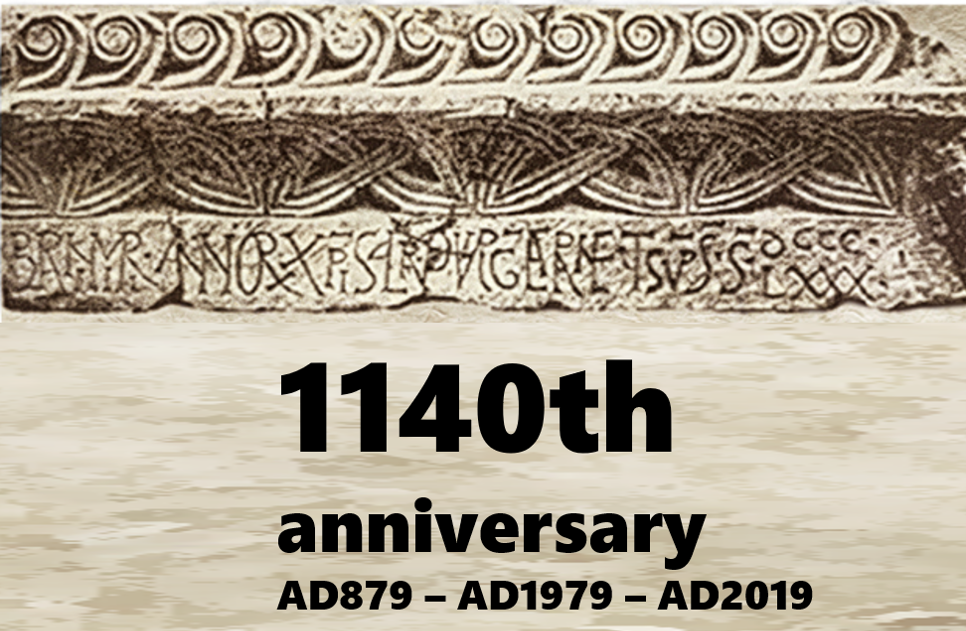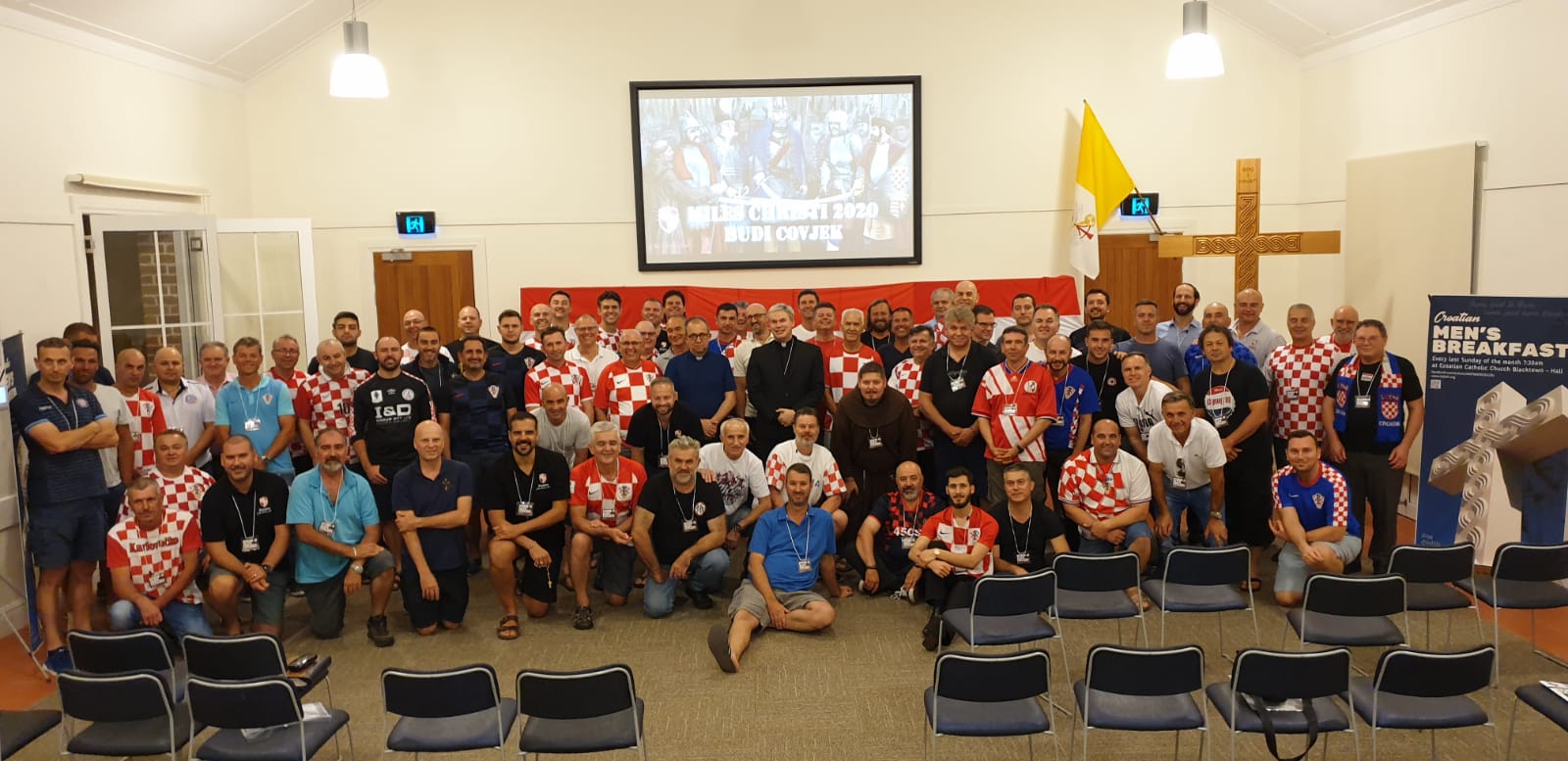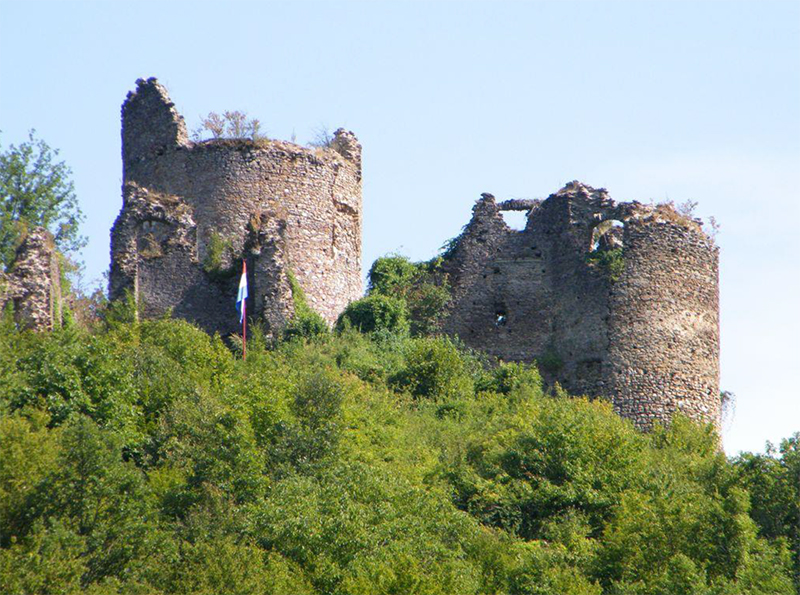Program for Celebrating 13 Centuries of Christianity amongst Croats (1975-1984)
After the suppression, of the “Croatian Spring” (1971), all free speech fell silent. Only the Church, spoke out, in its own tried and tested way so that people of faith would become more informed about their history. Thereby, recognising the religious roots of their identity. Due to God’s providence, at that time, the head of the Croatian episcopacy the servant of God, Card. Franjo Kuharić, was Archbishop of Zagreb. He was a great devotee and heir to Blessed Aloysius Stepinac, who as far back as 1941, planned to commemorate the thirteen-hundred-year anniversary of first relations between Croats and the Holy See (641). From the time of Pope John IV, a native of Dalmatia (said to be from Zadar). Stepinac’s proposal was interrupted by the war. But it was not stopped. His heir, Cardinal Franjo Kuharić, thirty years later, in a very unfavourable socio-political system – the communist-atheist state, prudently and calmly prepared the people and the Church in Croatia for major religious gatherings. They would have a unique contribution to their knowledge of their religious and national past, and recognising their roots of their religious and national identity.
The decision of the Croatian bishops was providential to thank God, over a 9-year period, for the gift of baptism, faith and belonging to the Catholic Church. After many years of “suppression of the Catholic and Croatian identity” under communism, every effort was needed to enable people to discover and recognize the roots of their Christian heritage and national roots.
This is how the history of the people’s gatherings began: From Solin (AD 1976), meditating on the gift of baptism, to the river Jadro, near Our Lady of the Isles, over to the Diocese of Knin ( AD 1978), and all the way to Nin (AD 1979), where reference was made to ties between the Croatian rulers with the Holy See. Especially, with Pope John VIII who on “Ascension Day (AD 879) raised his hands to heaven, and blessed Prince Branimir, all the Croatian people, and all their land.” The highpoint of the novena was at the Eucharistic Congress in Marija Bistrica in (AD 1984), were over half a million people gathered (Card. Kuharić and Zdenko Svete for Relations with Religious Communities: Everyone counted their own). It was a peaceful event – “people’s gathering” – that did not look for weapons, but prayed with the beads of their rosary. With faith, our advocate, Mary of the rosary, and with the rosary, our people recognised true strength of prayer and won freedom.
It is interesting to note, the day of Queen Jelena’s passing, is now the Independence Day of the Republic of Croatia, October 8 1991. The Croatian Parliament passed a resolution to break all ties with Yugoslavia. The concurrence of these two dates spanning a thousand years or more is no coincidence, nor is it a coincidence that the prayer procession began at the church of Our Lady of Isles, during the difficult times of repressive communist rule. On the same day, we commemorate Queen Jelena and the Independence Day of the Republic of Croatia, the calendar day also falls, on October 8, 1075, Croatian King Zvonimir was crowned at the hands of Pope’s envoy Gebizona. On receiving the sword, sceptre, crown and flag as a sign of faithfulness and submission to the Pope, he also made a promise, which he affirmed with his oath: “I, Dmitar Zvonimir, with the help of God and the gift of the apostolic chair, will always be faithful to St. Peter … and I will receive and treat the Pope’s envoy’s honourably and honestly. I will cultivate justice, defend the churches, protect the poor, widows and orphans. I will prevent illicit marriages and oppose the slavery. So help me God!”
With the date of the beginning of the nine-year journey from Solin, interwoven is our recent and past history, infused with faithfulness to God, the Church, the Pope and our nations roots. It also marked our centuries-old value system, identity, language, culture and our uniqueness in a common European Christian heritage. As we look back today from a certain historical distance about the plan and program of this great anniversary, we see that it was a brave act on behalf of the then Croatian bishops, whose fruits we continue to reap. It began about forty-two years ago with Our Lady of Isles in Solin, and gradually and consistently realised through “pilgrimages” to our shrines, from Solin through to the Diocese of Knin, and to Branimir’s year in Nin, and ended with the Eucharistic Congress at our National Marian Shrine at Marija Bistrica. And it all took place in the very complex circumstances of the time under communist rule.
Branimir’s year from Rome to Nin
Today, from a historical distance of four decades, we reflect on the solemnity of Branimir’s year celebration in Rome and in Nin. It is not possible to give an exhaustive and complete account of what happened before our believers’ eyes. And what such a celebration meant for that time and later. Especially what happened in Rome over the tomb of St. Peter the Apostle on April 30, 1979. Never before, have Croats, heard such a strong evaluation of their national and ecclesiastical history. Like long ago John VIII was to Croatian ruler Branimir, so did St John Paul II bless Croats with everything they hold dear and holy, in this world and in the next world, for this and for eternal life. Namely, the Church is not in the world to save and serve itself, but to serve everyone; to those who do not believe; to move every man and every nation to maintain himself in his dignity, in his identity, to be what he is, to become as happy and free as the Creator envisioned. To the Polish Pope, all this was crystal clear, he was not silent. He was not afraid to go beyond some boundaries by entering into service and the earthy life of man and nation. Our compatriot atheists also realized this. The ceremonial reception given in Rome for pilgrimage leaders and other distinguished guests by the Yugoslav ambassador to the Holy See showed that even the state can express gratitude to the Catholic Church without unnecessary scruples and fears.
Pope John Paul II. celebrated Mass in Croatian – St Peters Basilica Rome 30th April 1979
When St. Peter’s Basilica was filled and with the thunderous singing and applause of the Croatian pilgrims and Pope John Paul II with the concelebrant’s present came to the altar, Cardinal Franjo Kuharić in the name of all the bishops and priests present, addressed the consecrated persons of God and the people of God.
“Holy Father!
A pilgrimage of Catholic Croats is before you for the first time in your pontificate [6]. Our historic journey through the centuries has been difficult. In defence of our faith and our existence, we have shed many tears and paid the expensive price of blood. And while here in front of your holiness we present the entire history of the Croatian people, in humility of heart we dare repeat the words of St Paul: we have kept the faith (2Tim 4, 7). We have also preserved our fellowship with the Roman Catholic Church and we have maintained the faithfulness of St. Peter and his heirs. Immediately at the beginning of this joyous meeting, we express our warmest gratitude for giving us a special proof of your paternal love by celebrating with us the most Holy Eucharist in the language of the Croats. On this occasion, the 1100th anniversary of the famous exchange of letters between Pope John VIII and Croatian ruler Branimir, Bishop Theodosius, and the Pope’s letters to the people and the clergy. All three letters were dated 7 June 879.
We wanted to celebrate this significant jubilee with Peter’s successor at the very spot where Pope John VIII, over the tomb of Peter the Apostle, first initiated it. In 1976, it has been a thousand years since our Queen Jelena built the church of Solin in honour of the Mother of God. That year (1976) was an incentive for us to begin celebrating the anniversary of “Thirteen Centuries of Christianity among Croats.” We placed spiritual renewal under the special protection of the Blessed Virgin Mary. A thousand and a hundred years ago on the Feast of the Ascension of the Lord, Pope John VIII had blessed here on the tomb of St. Peter, Branimir and his people. Holy Father! We the present bishops and priests, monks and nuns, all the present pilgrims, sons and daughters of the Croatian people, humbly and faithfully ask that again here at the tomb of St. Peter, like so many of your forebears, you invoke all the blessings of God on us all, on our Church and on our people, on our beloved land. Strengthen your brethren (cf. Lk 22:32), Holy Father, with the Apostolic Blessing so that it would be so! Amen”.
Pope John Paul II’s speech to Croatian pilgrims followed. [7]. Held in the Basilica of St. Peter, given in the Croatian language in the presence of Croatian Cardinal Franjo Šeper, all Croatian archbishops and bishops, hundreds of priests, religious and nuns, and in the presence of tens of thousands of Croatian pilgrims from home and abroad:
My dear Croats!
Dear brothers in the Episcopate,
Dear priests, men and women religious,
Dear sons and daughters of “ever faithful” Croatia!
“Grace to you and peace from God the Father and our Lord Jesus Christ” (cf. Gal Ga 1,3). “With open arms I press you to me and welcome you with fatherly love” (Letter from Pope John VIII to the Croat people and clergy: Mansi, Sacrorum Conciliorum collectio, XVII, 126) here, on St Peter’s Tomb, on the occasion of the significant anniversary of the Croats’ profession of fidelity to the Holy See, which is at the same time the memory of the fatherly good will towards you of the Successors of St Peter.
There are many reasons that justify this common joy of ours, as my brother in the Episcopate, Archbishop Franjo Kuharic, said so well in his address.
Truly, in this meeting at St Peter’s Tomb, there seems to be concentrated your whole history of over thirteen centuries, and especially the great events of the life of your Church since the time of the Baptism of your people, when it entered the bosom of the Roman Church which is “head and teacher of all Churches” (Letter from Pope John VIII to the Bishop of Nin, Theodosius: Mansi, l.c., XVII, 124). Do you remember “White Croatia”, your land of origin, which is just where my native land is? I feel the presence of your beautiful and dear nation, of all your people inside and outside the frontiers of your country, of your old and new fidelities, your anxieties. Here is present the memory of your ancestors, your Christian princes and kings, your bishops and priests, your paleo-Croat liturgical language, your marvellous churches, and especially your Marian sanctuaries.
Meanwhile, today we recall especially the relations of Croatia with the Holy See, so clearly expressed in Pope John VIII’s letters to Prince Branimiro, to the Croat clergy and people, and to Bishop Theodosius. This happened precisely eleven centuries ago. The events of that time filled with joy the heart of Peter’s Successor, and they were decisive for the future history of the Croat people and of the Church, for your faith, culture, and political independence.
Having before my eyes the rich and centuries-old past of your people, it seems to me that I can stress the following three extraordinary aspects.
First: fidelity to Jesus Christ and to the Gospel; a fidelity to which your ancestors bore witness with the fervour and spirit of martyrs in the struggle throughout the centuries “for the noble Cross and golden freedom”.
Second: the love and adherence of the Croats to the Roman Church, to St Peter’s Chair. This Church was really, your Mother, at whose holy doctrine your ancestors quenched their thirst as at a clear spring” (Letter from Pope John VIII to the Croat prince Branimiro: Mansi, 1.c., XVII, 125).
Third: the love, the fidelity and the devotion of the Croats towards Mary, the Mother of God and Mother of the Church, whom you warmly invoke as “Queen of the Croats” and filially honour in your sanctuaries.
Today you also confirm this three-fold fidelity of yours as a “Great Vow” of faithfulness to Jesus, to the Church, and to the Mother of God—particularly after the jubilee solemnities at Marija Bistrica, Solin, and Biskupija. Be faithful, be constant, be proud of your Christian name!
While I raise my hands today to bless you who are present, the whole of your people and the whole of your land (ibidem), I beg the Lord to preserve your faith and I implore the Mother of God to be always and everywhere “your powerful advocate”. I extend my blessing to your bishops, priests, men and women religious in order that, faithful to their own vocation, they may be an example to all, and not go astray (Letter from Pope John VIII to the Bishop of Nin, Theodosius: Mansi, 1.c. XVII, 124), but may announce the Gospel of Christ as a joyful message of salvation, truth, love and concord. I bless all of you present, your families, young and old, workers and intellectuals, and I beg you: remain faithful to God and to Peter, foster a good family spirit, respect life, bring up a more and more numerous youth and keep the noble tradition of family prayer. I address, above all, you, young faithful: know and love Jesus Christ, man’s only Redeemer, and be proud of your Christian name.
I bless in a fatherly way also the many workers who have come from other lands. I am acquainted with the worries and difficulties of the workers, therefore I exhort you never to forget your faith, and to love your home, your Church, and your native land.
My dear Croats! I thank you for this meeting, for this expression of renewed fidelity. As Pope John VIII once did, today I too delight in your faith, your affection, and your fidelity to Jesus Christ and to his Church.
The Pope loves you.
The Pope embraces you and welcomes you.
The Pope blesses you! Amen
When we contemplate this Mass with the Pope in St. Peter’s Basilica, the first papal mass in history held in Croatian language, we conclude that it was an exultant event. After received praises, acknowledgments, and blessings, thwarted hopes were awakened that could bring about some changes, which could be achieved by ‘rolling up the sleeves instead of lifting our heads up’. And instead of our proverbial “outsmarting” of one another and pessimistic forecasts and speculations, to aim at establishing national unity and ecclesiastical unanimity in Croatia.
On our ecclesiastical foundation and foundation of our statehood
After the iconic and important pilgrimage to the tomb of the Apostolic Champion St. Peter, on April 30, 1979, lasting for four months, on September 2, 1979, the pilgrims headed for Nin. This gathering of unprecedented proportions also showed that the Church was lively, present and powerful among the people. And people’s broadest spectrum, both the old and the young, have shown that they have great trust in their Church and that they seek and expect something important from it.
In spite of numerous limitations, the Church listened and found ways to move multitudes within the broadest spectrum of people, especially when aiming at contents that resonated in the people’s soul and corresponded to its aspirations. Priests and parish priests were the chief workers and initiators of such movements. They enjoyed the trust of the people who were certain of being led along the paths of faithfulness to God and their homeland in the spirit of the Gospel of Jesus.
The aforementioned pilgrim gatherings at our shrines have managed to overcome all the painful wounds of our church life, our often unpleasant divisions and discord, and manifested true ecclesiastical vitality and trust shown in the cooperation of bishops, theologians, parish priests, consecrated persons of all ranks and colours, and lay believers of different thoughts, beliefs and commitments. Once again it was shown that the faithful people do not seek from the church leadership some kind of easy-going and diluted Christianity, but one that is imbued with prayer, penance and renunciation; Christianity that gathers us around Mary, where it is prayed and sacraments are sought and shared.
If any pilgrimage was difficult, not in the least touristy or tiring, it was the one towards Nin. It seemed after the Rome meeting that people might not respond. Yet, there were hundreds and hundreds of buses, cars, groups on trains and groups of pedestrians pouring in. Despite sleepless nights the pilgrims did not regret the effort to dress up in hundreds of folk costumes, to bring valuable church flags and other products of their folk art. And all with the to find themselves in unity with the Church and the people. How many pilgrims were there in Nin? It is hard to estimate. Some have numbered up to one thousand and two hundred buses; no one had even counted pilgrims arriving with personal cars. It was reported that there were no fewer than 250 thousand. Namely, the space covered by the pilgrims at the place of “Gregory” covers about 100,000 square meters. And the town of Nin was at no point getting smaller.
Regardless whether the number of pilgrims tallied to more or less than 250,000, no greater number of Croats ever assembled at a church gathering, like they did in Nin. Everyone commended the Archdiocese of Zadar and its central committee, which by rendering information in advance and on the spot, guidance managed to avoid any significant incidents and to ensure the dignity of the celebration and its content.
A number of media outlets praised the Nin residents, led by the parish priest don Čedo Šuprah, who according to chroniclers, have “exceeded the needs and demands of the pilgrims with their hospitality.”
Remembering with gratitude the “Branimir Year” as part of the grand celebration of thirteen centuries of Christianity among Croats [8], even after four decades, we feel a debt of gratitude to all who planned, organized and led this nine-year long pilgrimage program. We are especially grateful for the diligent shepherds, bishops and priests of that time, who helped the faithful to keep their loyalty and faithfulness to the Church and to Peter’s heir in those difficult moments of temptation. It is no exaggeration to say that the present national sovereignty and independence owes much to these events and to its engaged individuals. As spiritual inheritors, of the inheritance left to us by our ancestors, we join the many thousands who honour Mother Mary, who with heart and faith have acclaimed, prayed, sung, and thankfully repeated Our Lady’s praise, “My soul proclaims the greatness of the Lord,” because “the Mighty One has done great things for me.” Thank you.
Šibenik, 28. November 2018. – Priestly recollection
English text translated from original article in Croatian by Želimir Puljić, Archbishop Zadar http://www.zadarskanadbiskupija.hr/?p=30468
Note: The original Croatian article contained only partial homily of JPII, the full text of St. John Paul II homily was included in this translation, it was sourced from http://www.clerus.org/bibliaclerusonline/en/f4h.htm#czc
For the upcoming Men’s Conference Miles Christi 2026 which is less than two months away, as is our tradition we pray the 54 Day Rosary Novena for our Lord’s blessing upon the conference. We encourage all that can to join us, it is a great way to start praying the rosary daily, as requested by...Continue reading→
King Tomislav – and the Roman Catholic Church In 925, Pope John X summoned a Church Council (Synod) in Split, which was attended by King Tomislav, Knez Mihajlo Višević of Zahumlje, numerous Croatian nobles, along with Rascian nobles that previously escaped with Župan Zaharija from the Bulgarian conquest of Rascia. The Church Council confirmed Tomislav...Continue reading→
The most important thing is to leave a legacy for our children, to know who their ancestors were. Konavle, 18th September 2025. Parish of Our Lady of Mount Carmel, Plocice. Dubrovnik Bishop Roko Glasnovic blessed the monumental statue of St. Michael the Archangel. The statue is a gift, erected on the occasion of the 1100th...Continue reading→
King Tomislav – consolidation and expansion of the Croatian Kingdom Although Tomislav inherited a powerful and organised state, he was immediately threatened by the Magyars from the north and by the Bulgarians from the east. The banates of the former Adriatic Red Croatia (Zahumlje, Duklja and Travunia) remained subjected to the Byzantine Empire’s political and...Continue reading→
Nearly 100 years ago, on December 10, 1925, a quiet miracle unfolded in the small Spanish city of Pontevedra. Sister Lucia, the last surviving seer of Fatima, was staying with the Dorothean Sisters when she received an extraordinary vision. Before her appeared the Blessed Virgin Mary, radiant and sorrowful, with the Child Jesus at her...Continue reading→
This year marks the 1,100th anniversary of the coronation of King Tomislav, a pivotal figure whose leadership united the Croatian principalities into a formidable medieval kingdom. In this three-part article series, we will explore the remarkable life and enduring legacy of Croatia’s first crowned king, whose reign represents a critical foundation of Croatian national identity...Continue reading→
ACT OF CONSECRATION OF THE CROATIAN PEOPLE AND CROATIA TO THE SACRED HEART OF JESUS The Bishops of the Croatian Bishops’ Conference have decided to consecrate the Croatian people and Croatia to the Sacred Heart of Jesus in the Jubilee Year 2025. The Act of Consecration will take place on the Solemnity of the Sacred...Continue reading→
“Mladež roda hrvatskoga… svečano obeća, da će se pod barjakom Presvetog Srca Isusova hrabro i neustrašivo boriti za vjeru i za dom.” (“The youth of the Croatian people… solemnly promise to bravely and fearlessly fight for faith and for homeland under the banner of the Most Sacred Heart of Jesus.”) This line from the 1900...Continue reading→
U duhu svetog sjećanja i nacionalnog ohrabrenja, izrađen je ograničen broj jubilarne „Hrvatske Zavjetne Krunice“ kako bi se proslavila 125. obljetnica posvete 160.000 mladih Hrvata Presvetom Srcu Isusovu 1900. godine. Ova jubilarna krunica ima dvostruku misiju: sjećanje i ohrabrenje. SJEĆANJE Sjećati se svete prošlosti našeg naroda, našeg saveza s Kristom i Njegovom svetom Katoličkom Crkvom...Continue reading→
In the spirit of sacred remembrance and national encouragement, the “Hrvatska Zavjetna Krunica” (Croatian Covenant Rosary) 125th Anniversary Jubilee Limited Edition has been created to celebrate the 125th anniversary of the consecration of 160 000 young Croatians to the Sacred Heart of Jesus in AD 1900. This Jubilee edition rosary bears a twofold mission: to...Continue reading→























You must be logged in to post a comment.